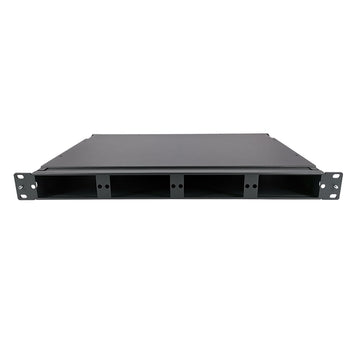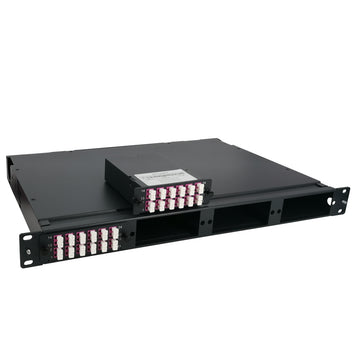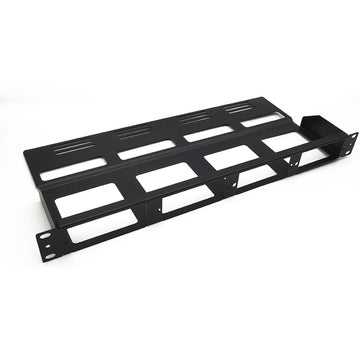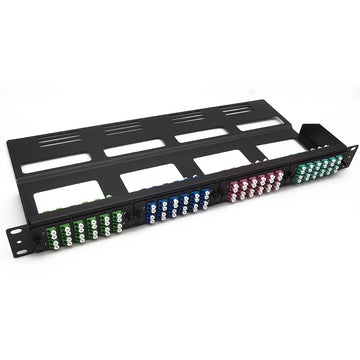200G QSFP56 AOC Introduction and Application
What is a 200G QSFP56 AOC?
200G QSFP56 AOC is a QSFP56 VCSEL (Vertical Cavity Surface-Emitting Laser) based active optical cable (AOC) designed for use in 200Gb/s Ethernet or InfiniBand HDR systems. The 200G QSFP56 AOC offers high-end port density and configurability, and a much longer reach than passive copper cables in the data centers. 200G QSFP56 AOC has a standard SFF-8665 compliant QSFP56 port on the electrical side towards the host system. It contains four channels multi-mode fibers (MMF) optic transceivers per end, each channel of transceivers operates data rates up to 50Gb/ with PAM4 modulated signals (4x 50G PAM4). Assembled with fixed length of fiber cable, the AOC is easy to install and replace. The high quality 200G QSFP56 AOC (active optical cable) solutions provide power-efficient connectivity for data center interconnects. They enable higher port bandwidth, density and configurability at a low cost,and reduced power requirement in the data centers.Applications of 200G QSFP56 AOC
A 200G QSFP56 AOC (Active Optical Cable) is a high-speed optical interconnect solution that uses a QSFP56 (Quad Small Form-Factor Pluggable) form factor and supports a data rate of 200 gigabits per second. Here are some common use cases for a 200G QSFP56 AOC:Data Centers: AOCs are frequently used in data centers to connect switches, routers, and other networking equipment. The high data rate of 200G makes them suitable for high-performance computing and large-scale data processing applications.
High-Performance Computing (HPC): HPC clusters and supercomputers often require high-speed interconnects to handle the massive amounts of data generated by scientific and computational tasks. 200G QSFP56 AOCs can be used to link various components within an HPC environment.
Artificial Intelligence (AI) and Machine Learning (ML): AI and ML applications often involve intense data processing. A high-speed interconnect like the 200G QSFP56 AOC can facilitate the quick transfer of data between GPUs (Graphics Processing Units) or other accelerators in a server or cluster.
Telecommunications: In telecommunications infrastructure, high-speed connections are essential for transmitting large volumes of data. AOCs can be used in the networking equipment deployed in telecommunications networks.
Storage Area Networks (SANs): AOCs are commonly used in SANs to connect storage devices, providing high-speed data transfer between servers and storage arrays.
Cloud Computing: Cloud service providers use high-speed interconnects to ensure efficient communication between servers in their data centers. AOCs can be employed in cloud environments to meet the demand for fast and reliable data transmission.
Comparing 200G QSFP56 AOC with Other Connectivity Options
When assessing the value of the 200G QSFP56 AOC, it’s essential to compare it with other popular connectivity options such as Direct Attach Copper (DAC) cables and traditional optical transceivers.
Comparison with Direct Attach Copper (DAC) Cables
Compared to DAC cables, the 200G QSFP56 AOC offers significant advantages. First, AOCs provide a longer transmission distance. DAC cables are typically limited to short-range communications, whereas the AOC can support a transmission range of up to 100 meters on OM4 multimode fiber. This makes AOCs more flexible for short- and medium-range network connections.
Second, AOCs have lower power consumption. DAC cables, especially at high data rates, consume more power due to the electrical signals transmitted through copper cables. In contrast, AOCs use optical signals, which are more energy-efficient, reducing the power consumption of your network infrastructure.
Third, AOCs are lighter and more flexible than DAC cables, making them easier to install and manage within the data center environment.
Comparison with 200G QSFP56 SR4 Transceivers
The 200G QSFP56 AOC also outperforms traditional optical transceivers in several ways. For one, AOCs integrate the transceiver modules and optical cables into one unit, eliminating the need for separate components and reducing the risk of compatibility issues between different manufacturers.
Additionally, AOCs offer higher reliability and signal integrity. The connectors are factory pre-terminated, and the optical link is fully enclosed, protecting it from dust, dirt, and other contaminants that can degrade signal quality in traditional transceiver setups.
Finally, AOCs provide a cost-effective solution. Traditional optical transceivers require separate purchases of transceiver modules and cables. In contrast, AOCs combine these into a single purchase, providing a more economical choice for high-speed data communications.
In summary, the 200G QSFP56 AOC presents an advantageous solution over DAC cables and traditional 200G QSFP56 SR4 transceivers regarding distance, power efficiency, installation ease, reliability, and cost-effectiveness. As such, it is a compelling choice for data centers looking to enhance their network performance and efficiency.













